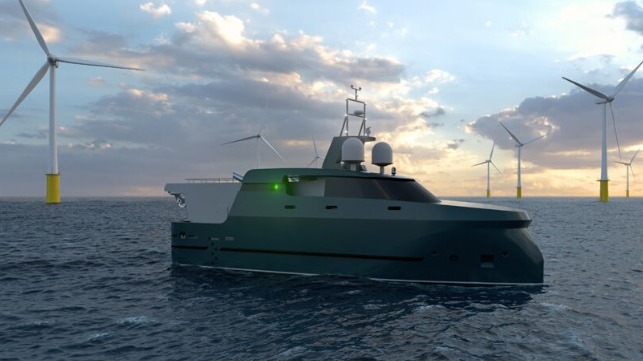Remotely-Operated USV Ordered for Subsea Inspections and Maintenance Work

Companies are looking to use the advancements in remote operation and uncrewed vessel technologies to increase capabilities and reduce the economic and safety risks in a range of tasks require for offshore wind farm development and other subsea tasks. A Norwegian joint venture company, USV, established by DeepOcean, Solstad Offshore, and Østensjø, has contracted for its first unmanned surface vessel (USV) specifically designed for subsea inspection, maintenance, and repair work.
The design incorporates a broad range of capabilities to permit the vessel to conduct subsea operations. During operations, both the USV vessel crew and ROV operators will be co-located in the same remote operating center.
It will be equipped with a sizeable tool package which the company says will give the vessel the capability of handling most subsea inspection work and a significant part of subsea intervention tasks while operating remotely controlled from shore with no onboard crew. It will also have an ROV and the company reports it has a newly developed launch and recovery system which allows for work class ROVs to be operated from relatively small vessels, such as the USV.
“With our new USV, we are moving the captain onshore who will remain in control over the offshore operations,” said Øyvind Mikaelsen, Chair of USV and CEO of DeepOcean. “We will operate the vessel and the ROV from an onshore remote operations center. This is an excellent way of reducing cost, CO2 footprint and limiting personnel exposure to offshore operations.”
USV has contracted the Astilleros Gondán shipyard in Figueras, Spain to build the USV. Delivery is expected by the end of 2024. Following offshore testing, the company expects it will be ready for operations in 2025.
The USV will be nearly 79 feet in length and 25 feet wide. A hybrid diesel-electric propulsion system, which also includes a battery package from Seam, will allow the unmanned vessel to operate offshore for up to 30 days without charging or refueling. The ROV will be capable of operating down to 1,500 meters of water depth. Maritime Robotics will deliver the system that enables auto-remote control and navigation for the USV. Once in operation, they are projecting that the vessel can also reduce CO2 emissions by more than 90 percent compared to a conventional offshore vessel conducting similar subsea tasks.
The partners report the concept has been under development since 2018. The design work was conducted in close collaboration with clients, Salt Ship Design, technology providers, and the relevant authorities to enhance the capabilities of the USV.
Last month, Ørsted, one of the leading developers of offshore wind farms, announced that it was also using the advancements in remote operations and uncrewed vessels to enhance its surface operations in support of future wind farm developments. They reported that they completed testing of a prototype USV, named Hugin USV, designed for offshore met-ocean measurement campaigns. They are planning to proceed with up to five of their USVs to conduct efforts to gather data critical to early-phase development data for future offshore wind farms.
